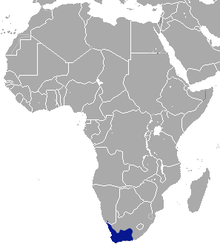| Cape elephant shrew | |
|---|---|
| Conservation status | |
 Least Concern (IUCN 3.1) | |
| Scientific classification | |
| Domain: | Eukaryota |
| Kingdom: | Animalia |
| Phylum: | Chordata |
| Class: | Mammalia |
| Order: | Macroscelidea |
| Family: | Macroscelididae |
| Genus: | Elephantulus |
| Species: | E. edwardii |
| Binomial name | |
| Elephantulus edwardii (A. Smith, 1839) | |

| |
| Cape elephant shrew range | |
| Synonyms | |
| |
The Cape elephant shrew (Elephantulus edwardii), also known as the Cape rock elephant-shrew or Cape rock sengi, is a species of elephant shrew in the family Macroscelididae. It is endemic to South Africa, although it is a relatively common animal. Its natural habitat is rocky areas. Elephant shrews are not closely related to true shrews, nor to rodents such as mice. E. edwardii has been observed to be a non-flying mammal pollinator of the pagoda lily (Massonia bifolia). Elephant shrews are floral pollinators due to their largely insectivorous diet. Elephant-shrews are pollinators of Hyobanche atropurpurea. It uses its long slender tongue to feed on the pagoda lily's nectar while getting the lily's pollen on its long nose. E. edwardii is also a pollinator of Protea sulphurea.
References
- ^ Rathbun, G.B.; Smit-Robinson, H. (2015). "Elephantulus edwardii". IUCN Red List of Threatened Species. 2015: e.T7136A21290344. doi:10.2305/IUCN.UK.2015-2.RLTS.T7136A21290344.en. Retrieved 13 November 2021.
- ^ Schlitter, D.A. (2005). Wilson, D.E.; Reeder, D.M. (eds.). Mammal Species of the World: A Taxonomic and Geographic Reference (3rd ed.). Johns Hopkins University Press. p. 82. ISBN 978-0-8018-8221-0. OCLC 62265494.
- ^ Jiang, Jin-Qing; Xia, Xiao-Jing; Wang, Lei; Liu, Chang-Zhong (2018). "Characterization of the complete mitochondrial genome of cape elephant shrew, Elephantulus edwardii". Mitochondrial DNA Part B. 3 (2): 738–739. doi:10.1080/23802359.2018.1483759. PMC 7799720. PMID 33474305.
- ^ Petra Wester, "Sticky snack for sengis: The Cape rock elephant-shrew, Elephantulus edwardii (Macroscelidea), as a pollinator of the Pagoda lily, Whiteheadia bifolia (Hyacinthaceae)", Springer-Verlag, November 16, 2010. Retrieved 2019-04-11.
- Wester, Petra (2011). "Nectar feeding by the Cape rock elephant-shrew Elephantulus edwardii (Macroscelidea) — A primarily insectivorous mammal pollinates the parasite Hyobanche atropurpurea (Orobanchaceae)". Flora - Morphology, Distribution, Functional Ecology of Plants. 206 (12): 997–1001. Bibcode:2011FMDFE.206..997W. doi:10.1016/j.flora.2011.05.010.
- Wester, Petra (2010). "Sticky snack for sengis: The Cape rock elephant-shrew, Elephantulus edwardii (Macroscelidea), as a pollinator of the Pagoda lily, Whiteheadia bifolia (Hyacinthaceae)". Naturwissenschaften. 97 (12): 1107–1112. Bibcode:2010NW.....97.1107W. doi:10.1007/s00114-010-0723-6. ISSN 0028-1042. PMID 21080154. S2CID 8649184.
- Kühn, N., Midgley, J. & Steenhuisen, S.-L. (2017). Reproductive biology of three co-occurring, primarily small-mammal pollinated Protea species (Proteaceae). South African Journal of Botany. 113: 337-345. https://doi.org/10.1016/j.sajb.2017.08.020.
| Taxon identifiers | |
|---|---|
| Elephantulus edwardii |
|
This Macroscelidea-related article is a stub. You can help Misplaced Pages by expanding it. |